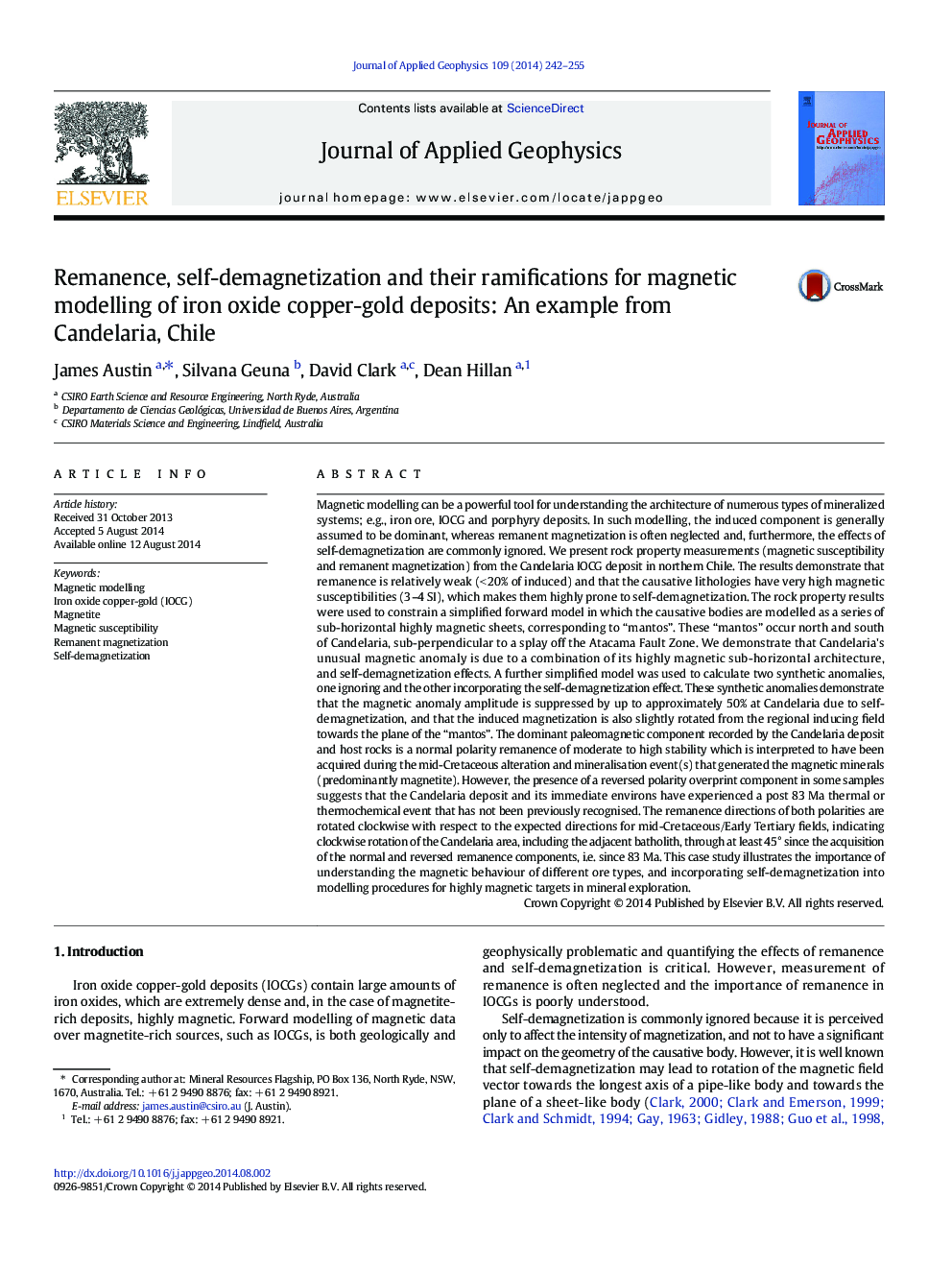| کد مقاله | کد نشریه | سال انتشار | مقاله انگلیسی | نسخه تمام متن |
|---|---|---|---|---|
| 4740047 | 1641142 | 2014 | 14 صفحه PDF | دانلود رایگان |

• Remanence is commonly < 20% of induced magnetization in magnetite-rich IOCGs.
• High magnetic susceptibility lithologies are highly prone to self-demagnetization.
• Self-demagnetization causes up to 50% suppression of Candelaria's magnetic anomaly.
• Highly magnetic sub-horizontal sheets cause Candelaria's unusual magnetic anomaly.
• Remanence vectors indicate the Candelaria orebody has rotated ~ 45° since 83 Ma.
Magnetic modelling can be a powerful tool for understanding the architecture of numerous types of mineralized systems; e.g., iron ore, IOCG and porphyry deposits. In such modelling, the induced component is generally assumed to be dominant, whereas remanent magnetization is often neglected and, furthermore, the effects of self-demagnetization are commonly ignored. We present rock property measurements (magnetic susceptibility and remanent magnetization) from the Candelaria IOCG deposit in northern Chile. The results demonstrate that remanence is relatively weak (< 20% of induced) and that the causative lithologies have very high magnetic susceptibilities (3–4 SI), which makes them highly prone to self-demagnetization. The rock property results were used to constrain a simplified forward model in which the causative bodies are modelled as a series of sub-horizontal highly magnetic sheets, corresponding to “mantos”. These “mantos” occur north and south of Candelaria, sub-perpendicular to a splay off the Atacama Fault Zone. We demonstrate that Candelaria's unusual magnetic anomaly is due to a combination of its highly magnetic sub-horizontal architecture, and self-demagnetization effects. A further simplified model was used to calculate two synthetic anomalies, one ignoring and the other incorporating the self-demagnetization effect. These synthetic anomalies demonstrate that the magnetic anomaly amplitude is suppressed by up to approximately 50% at Candelaria due to self-demagnetization, and that the induced magnetization is also slightly rotated from the regional inducing field towards the plane of the “mantos”. The dominant paleomagnetic component recorded by the Candelaria deposit and host rocks is a normal polarity remanence of moderate to high stability which is interpreted to have been acquired during the mid-Cretaceous alteration and mineralisation event(s) that generated the magnetic minerals (predominantly magnetite). However, the presence of a reversed polarity overprint component in some samples suggests that the Candelaria deposit and its immediate environs have experienced a post 83 Ma thermal or thermochemical event that has not been previously recognised. The remanence directions of both polarities are rotated clockwise with respect to the expected directions for mid-Cretaceous/Early Tertiary fields, indicating clockwise rotation of the Candelaria area, including the adjacent batholith, through at least 45° since the acquisition of the normal and reversed remanence components, i.e. since 83 Ma. This case study illustrates the importance of understanding the magnetic behaviour of different ore types, and incorporating self-demagnetization into modelling procedures for highly magnetic targets in mineral exploration.
Journal: Journal of Applied Geophysics - Volume 109, October 2014, Pages 242–255